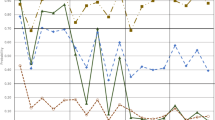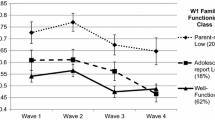Abstract
Physical aggression between spouses is a serious social problem. This study was designed to determine if social climate is different in the homes where aggression occurs than in nonviolent homes. Students were asked to report whether physical aggression between spouses occurred in their homes during their last 2 years of high school. They were also asked to complete the Marlowe-Crowne Social Desirability Scale (MC-SDS) and the Family Environment Scale (FES). Each student protocol with reported conjugal violence was matched with another protocol with an identical score on the MC-SDS and on which physical aggression was not reported. A multivariate analysis of variance indicated that these two groups differed in their scores on the FES. A dominance hierarchy, openly expressed anger, conflict, and lack of organization were salient characteristics of homes where physical aggression occurred. Nonviolent families were characterized by spontaneous expression of feelings and problems, shared pleasurable activities and goals, and an emphasis on personal rights and freedoms.
Similar content being viewed by others
References
Bandura, A. (1973).Aggression: A Social Learning Analysis, Prentice-Hall, Englewood Cliffs, N.J.
Birkimer, J. C., and Brown, J. N. (1979). Back to basics: Percentage agreement measures are adequate but there are easier ways.J. Appl. Behav. Anal. 12: 535–543.
Bromet, E., and Moos, R. H. (1977). Environmental resources and the posttreatment functioning of alcoholic patients.J. Health and Social Behav. 18: 326–338.
Cronkite, R. C., and Moos, R. H. (1980). Determinants of posttreatment functioning of alcoholic patients: A conceptual framework.J. Consult. Clin. Psychol. 48: 305–316.
Crowne, D. P., and Marlowe, D. (1960). A new scale of social desirability independent of psychopathology.J. Consult. Psychol. 24: 349–354.
Finney, J. W., Moos, R. H., and Mewborn, C. R. (1980). Posttreatment experiences and treatment outcome of alcoholic patients six months and two years after hospitalization.J. Consult. Clin. Psychol. 48: 17–29.
Gayford, J. J. (1975). Wife battering: A preliminary survey of 100 cases.Brit. Med. J. 1: 194–197.
Gelles, R. J. (1974).The Violent Home, Sage, Beverly Hills, Calif.
Giles-Sims, J. (1983).Wife Battering: A Systems Theory Approach, The Guilford Press, New York.
Goode, W. J. (1971). Force and violence in the family.J. Marriage Family 33: 624–635.
Hathaway, S. R., and McKinley, J. C. (1951).The Minnesota Multiphasic Personality Inventory Manual (Revised), The Psychological Corporation, New York.
Hilberman, E., and Munson, K. (1978). Sixty battered women.Victimol. Int. J. 2: 460–470.
Hofeller, K. H. (1982).Social, Psychological and Situational Factors in Wife Abuse, R & E Research Associates, Inc., Palo Alto, Calif.
Koegel, R. L., Schreibman, L., O'Neill, R. E., and Burke, J. C. (1983). The personality and family interaction characteristics of parents of austic children.J. Consult. Clin. Psychol. 5: 683–692.
Levinger, G. (1966). Sources of marital dissatisfaction among applicants for divorce.Am. J. Orthopsychiat. 36: 806–807.
Millham, J. (1974). Two components in need of approval score and their relationship to cheating following success and failure.J. Res. Personality 8: 378–392.
Mitchell, R. E., and Hodson, C. A. (1983). Coping with domestic violence: Social support and psychological health among battered women.Am. J. Commun. Psychol. 11: 629–654.
Moos, R. H. (1974).Family Environment Scale: Preliminary Manual, Consulting Psychologists Press, Palo Alto, Calif.
Moos, R. H., and Moos, B. A. (1976). Typology of family social environments.Family Process 15: 357–371.
National Center for Health Statistics (1976).Vital Statistics Report, Vol. 24, National Center for Health Statistics, Washington, D.C.
O'Brien, J. E. (1971). Violence in divorce-prone families.J. Marriage Family 33: 692–698.
Prescott, S., and Letko, C. (1977). Battered women: A social psychological perspective. In Roy, M. (ed.),Battered Women, Van Nostrand Company, New York.
Resick, P. A. (1983). Sex role stereotypes and violence against women. In Franks, V., and Rothblum, E. D. (eds.),The Stereotyping of Women: Its Effects on Mental Health, Springer, New York, pp. 230–256.
Rosenbaum, A., and O'Leary, K. D. (1981). Marital violence: Characteristics of abuse couples.J. Consult. Clin. Psychol. 49: 63–71.
Rounsaville, B. J. (1978). Battered wives: Barriers to identification and treatment.Am. J. Orthopsychiat. 48: 487–494.
Rounsaville, B., and Weissman, M. M. (1977–1978). Battered women: A medical problem requiring detection.Int. J. Psychiat. Med. 8: 191–202.
Safilios-Rothschild, C. (1970). The study of family power structure: A review 1960–1969.J. Marriage Family 32: 539–552.
Siegal, S. (1956).Nonparametric Statistics for the Behavioral Sciences, McGraw-Hill, New York.
Snyder, D.K., and Fruchtman, L. A. (1981). Differential patterns of wife abuse: A data-based typology.J. Consult. Clin. Psychol. 49: 878–885.
Steinmetz, S. K. (1977).The Cycle of Violence: Assertive, Aggressive, and Abusive Family Interaction, Praeger, New York.
Straus, M. A. (1973). A general system theory approach to a theory of violence between family members.Social Sci. Info. 105–125.
Straus, M. A. (1974). Leveling, civility, and violence in the family.J. Marriage Family 36: 13–29.
Straus, M. A. (1977). Sociological perspective on the prevention and treatment of wifebeating. In Roy, M. (ed.),Battered Women, Van Nostrand Reinhold, New York.
Straus, M. A. (1978). Wife-beating: How common and why?Victimology 2: 443–458.
Straus, M. A. (1979). Measuring intrafamily conflict and violence: The Conflict Tactics (CT) scales.J. Marriage Family 41.
Truninger, E. (1971). Marital violence: The legal solutions.Hastings Law J. 23: 259–276.
Walker, L. E. (1979).The Battered Woman, Harper and Row, New York.
Wolfgang, M. E. (1958).Patterns in Criminal Homicide, Wiley, New York.
Yarrow, M. R., Campbell, J. D., and Burton, R. V. (1970). Recollections of childhood: A study of the retrospective method.Monogr. Society Child Devel. 35: 1–74.
Author information
Authors and Affiliations
Rights and permissions
About this article
Cite this article
Resick, P.A., Reese, D. Perception of family social climate and physical aggression in the home. J Fam Viol 1, 71–83 (1986). https://doi.org/10.1007/BF00977033
Received:
Issue Date:
DOI: https://doi.org/10.1007/BF00977033




